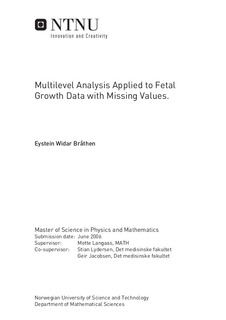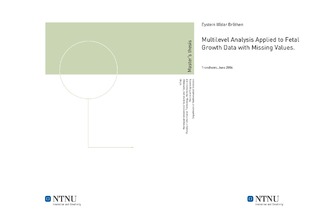| dc.description.abstract | Intrauterine growth retardation means that the growth of a fetus is restricted as compared with its biological growth potential. This contributes to an increased risk
for illnesses or death of the newborn. Therefore it is important to characterize, detect and to follow up clinically any suspected or confirmed growth restriction of
the fetus. In this master thesis we aim to describe the course of growth during the pregnancy based on repeated ultrasound measurements and study how the growth depends on different
background variables of the mother in analyzing the data from the SGA (small-for-getational age) - project.
The SGA-project contains data from 5722 pregnancies that took place in Trondheim, Bergen and Uppsala from 1986-1988, named The Scandinavian SGA-studies. In this thesis we have confined ourselves to a random sample of 561 pregnancies.
A problem with many studies of this kind is that the data set contain missing values. In the SGA data set under study there were missing values from one or more of the ultrasound measurements for approximately 40% of the women. Until recently, the most popular used missing-data method available has been complete case analysis, where only subjects with a complete set of data are being analysed. There exist a number of alternative ways of dealing with missing data. Bayesian multiple imputation (MI) has become a highly useful paradigm for handling missing values in many settings. In this paper we compare 2 general approaches that come highly recommended: Bayesian MI and maximum likelihood (ML), and point out some of its unique features. One aspect of MI is the separation of the imputation phase from the analysis phase. It can be advantageous in settings where the models underlying the two phases are different.
We have used a multilevel analysis for the course of fetal growth. Multilevel analysis has a hierarchic structure with two levels of variation:
variation between points in time for the same fetus (level 1) and variation between fetuses (level 2).
Level 1 is modeled by regression analysis with gestational age as the independent variable and level 2 is modeled by regarding the regression coefficients
as stochastic with a set of (non directly observed) values for individual fetuses and some background variables of the mother.
The model we ended up with describes the devolopment in time of the abdominal diameter (MAD) of the fetus. It had several ``significant'' covariates (p-value < 0.05), they were gestational age (Time-variable), the body-mass index (BMI), age of the mother, an index varible wich tells if a mother has given birth to a low-weight child in an earlier pregnancy and the gender of the fetus. The last covariate was not significant in a strictly mathematical way, but since it is well known that the gender of the fetus has an important effect we included gender in the model as well. When we used the MI-method on the random sample (561) with missing values, the estimated standard deviations of the parameters have been reduced compared to those obtained from the complete case analysis. There were not a significant change in the parameter estimates except for the coefficient for the age of the mother.
We also have found a procedure to verify if the MI-method gives us reasonable imputed values for the missing values by following the MCAR-procedure defined in Section 6. Another interesting observation from a simulation study is that estimates of the coefficients for variables used to generate the MAR and MNAR missing mechanism are ``suffering'' because they tend to be more biased compared to the values from the complete case analysis on the random sample (320) than the other variables. According to the MAR assumption such a procedure should give unbiased parameter estimates.
{Key Words: Longitudinal data, multilevel analysis, missing data, multiple imputation (MI), Gibbs sampling, linear mixed-effects model and maximum likelihood (ML)-procedure. | |

